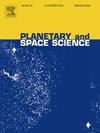用于行星科学的光热光谱:中红外吸收变得容易
IF 1.7
4区 物理与天体物理
Q3 ASTRONOMY & ASTROPHYSICS
引用次数: 0
摘要
对太阳系的形成和演化的认识仍有许多未解之谜。太阳系中固体的形成,矿物和有机的混合,以及行星体的形成都是社区感兴趣的话题。研究这些现象通常通过观测、遥感和原位分析来进行,但这些方法存在局限性。诸如红外衍射极限、空间分辨率问题和光谱分辨率问题等限制会阻碍有机物的检测、细胞结构的检测和鉴定以及颗粒混合物的解开。光学-光热红外光谱(O-PTIR)是目前应用于行星科学以外领域的一种相对较新的光谱方法。O-PTIR是一种非破坏性的、高度可重复的、快速的测量形式,能够减少这些限制。使用双激光系统,将红外光源调至中红外波长,我们进行了实验室O-PTIR测量,将O-PTIR数据与现有的红外吸收数据和行星材料的实验室FTIR测量结果进行比较。我们这样做的目的是向行星科学界介绍O-PTIR。这里介绍的技术将有助于在现场分析中更好地测量行星体。这是由于该技术能够匹配中红外吸收特征,同时在亚微米水平上进行非接触分析。我们发现,对于本工作中讨论的材料,O-PTIR能够利用已知的特征和可比吸收光谱峰来识别材料。本文章由计算机程序翻译,如有差异,请以英文原文为准。
Photothermal spectroscopy for planetary sciences: Mid-IR absorption made easy
The understanding of the formation and evolution of the solar system still has many unanswered questions. Formation of solids in the solar system, mineral and organic mixing, and planetary body creation are all topics of interest to the community. Studying these phenomena is often performed through observations, remote sensing, and in-situ analysis, but there are limitations to the methods. Limitations such as IR diffraction limits, spatial resolution issues, and spectral resolution issues can prevent detection of organics, detection and identification of cellular structures, and the disentangling of granular mixtures. Optical-PhotoThermal InfraRed (O-PTIR) spectroscopy is a relatively new method of spectroscopy currently used in fields other than planetary sciences. O-PTIR is a non-destructive, highly repeatable, and fast form of measurement capable of reducing these limitations. Using a dual laser system with an IR source tuned to the mid-IR wavelength we performed laboratory O-PTIR measurements to compare O-PTIR data to existing IR absorption data and laboratory FTIR measurements for planetary materials. We do this for the purpose of introducing O-PTIR to the planetary science community. The technique featured here would serve to better measurements of planetary bodies during in-situ analysis. This is due to the technique’s ability to match absorption features in the mid-IR while performing non-contact analysis at a sub-micron level. We find that for the materials discussed in this work, O-PTIR was capable of identifying materials when utilizing known features and peaks of comparable absorption spectra.
求助全文
通过发布文献求助,成功后即可免费获取论文全文。
去求助
来源期刊

Planetary and Space Science
地学天文-天文与天体物理
CiteScore
5.40
自引率
4.20%
发文量
126
审稿时长
15 weeks
期刊介绍:
Planetary and Space Science publishes original articles as well as short communications (letters). Ground-based and space-borne instrumentation and laboratory simulation of solar system processes are included. The following fields of planetary and solar system research are covered:
• Celestial mechanics, including dynamical evolution of the solar system, gravitational captures and resonances, relativistic effects, tracking and dynamics
• Cosmochemistry and origin, including all aspects of the formation and initial physical and chemical evolution of the solar system
• Terrestrial planets and satellites, including the physics of the interiors, geology and morphology of the surfaces, tectonics, mineralogy and dating
• Outer planets and satellites, including formation and evolution, remote sensing at all wavelengths and in situ measurements
• Planetary atmospheres, including formation and evolution, circulation and meteorology, boundary layers, remote sensing and laboratory simulation
• Planetary magnetospheres and ionospheres, including origin of magnetic fields, magnetospheric plasma and radiation belts, and their interaction with the sun, the solar wind and satellites
• Small bodies, dust and rings, including asteroids, comets and zodiacal light and their interaction with the solar radiation and the solar wind
• Exobiology, including origin of life, detection of planetary ecosystems and pre-biological phenomena in the solar system and laboratory simulations
• Extrasolar systems, including the detection and/or the detectability of exoplanets and planetary systems, their formation and evolution, the physical and chemical properties of the exoplanets
• History of planetary and space research
 求助内容:
求助内容: 应助结果提醒方式:
应助结果提醒方式:


